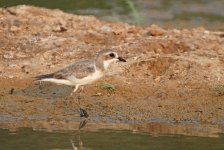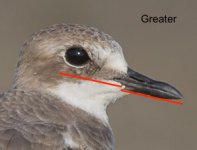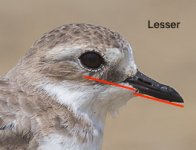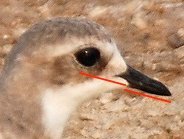-
Welcome to BirdForum, the internet's largest birding community with thousands of members from all over the world. The forums are dedicated to wild birds, birding, binoculars and equipment and all that goes with it.
Please register for an account to take part in the discussions in the forum, post your pictures in the gallery and more.
You are using an out of date browser. It may not display this or other websites correctly.
You should upgrade or use an alternative browser.
You should upgrade or use an alternative browser.
Plover ID from Al Ain, UAE, 09.06.2019. (1 Viewer)
- Thread starter peterarras
- Start date
More options
Who Replied?Andy Adcock
Worst person on Birdforum

Greater Sandplover for me.
orientaldkf
Well-known member
Could it be a lesser sand plover? Bill looks a little too short.
Andy Adcock
Worst person on Birdforum

Could it be a lesser sand plover? Bill looks a little too short.
If it were, it would be at the top end of size range I think but there is overlap between the smallest Greater and largest Lesser races which adds just another strand to this particular ID challenge.
orientaldkf
Well-known member
So far I have been following some ID guides that I've read online and what I usually do is measure the length of the lower mandible and compare it to the distance between the lower mandible to the eye. For greater sand plovers, the lower mandible length usually extends to the rear of the eye, while for lesser land plovers the lower mandible length only extends to halfway across the eye (from what I've observed). This one seems to fall a little short! But as you mentioned there is some overlap between the sizes of the two species, which makes it more challenging to ID without other individuals to compare it against.
Andy Adcock
Worst person on Birdforum

So far I have been following some ID guides that I've read online and what I usually do is measure the length of the lower mandible and compare it to the distance between the lower mandible to the eye. For greater sand plovers, the lower mandible length usually extends to the rear of the eye, while for lesser land plovers the lower mandible length only extends to halfway across the eye (from what I've observed). This one seems to fall a little short! But as you mentioned there is some overlap between the sizes of the two species, which makes it more challenging to ID without other individuals to compare it against.
I've highlighted the key word.
Experienced observers will consider a range of features such as general structure, leg length and colour, bill length and structure of the bill and even then, it can be difficult, especially with winter plumaged birds.
One diagnostic feature which is visible in flight, or can be, is the feet which depending on which species it is, will either protrude beyond the tail or not.
Greater Sandplover for me.
And me too. Two reasons: clearly yellowish legs [not a constant character—overlaps—but indicative], and bill length longer [~60 pixels] than distance from bill base to back of eye [~40]
orientaldkf
Well-known member
And me too. Two reasons: clearly yellowish legs [not a constant character—overlaps—but indicative], and bill length longer [~60 pixels] than distance from bill base to back of eye [~40]
Not sure if I'm doing the measurements correctly (have found this method reliable so far but open to pointers from others), attached some examples I tried measuring for comparison. And yes, I agree that a combination of features are to be considered and that pale legs are a feature to look out for although not diagnostic.
Attachments
johnallcock
Well-known member
Lesser SP for me. Based on the rounded head, large eye, blunt-tipped bill and overall proportions. Overall it looks like quite a small bird as well.
Leg colour is not entirely reliable on sandplovers, because it can vary according to age (young birds have paler legs), season and bleaching. I think a bird with blackish legs in breeding plumage will normally be LSP but harder on a non-breeding bird.
For bill length, it can be hard to judge on some birds. Remember that foreshortening also affects the apparent length if the head is turned slightly (as on this bird). FWIW I personally think it actually looks too short on this bird for GSP. Bill bluntness is often a better indication than overall length (blunt on LSP, sharp on GSP), and I would say that this bird has quite a blunt bill.
Leg colour is not entirely reliable on sandplovers, because it can vary according to age (young birds have paler legs), season and bleaching. I think a bird with blackish legs in breeding plumage will normally be LSP but harder on a non-breeding bird.
For bill length, it can be hard to judge on some birds. Remember that foreshortening also affects the apparent length if the head is turned slightly (as on this bird). FWIW I personally think it actually looks too short on this bird for GSP. Bill bluntness is often a better indication than overall length (blunt on LSP, sharp on GSP), and I would say that this bird has quite a blunt bill.
MJB
Well-known member
Lesser SP for me. Based on the rounded head, large eye, blunt-tipped bill and overall proportions. Overall it looks like quite a small bird as well.
Leg colour is not entirely reliable on sandplovers, because it can vary according to age (young birds have paler legs), season and bleaching. I think a bird with blackish legs in breeding plumage will normally be LSP but harder on a non-breeding bird.
For bill length, it can be hard to judge on some birds. Remember that foreshortening also affects the apparent length if the head is turned slightly (as on this bird). FWIW I personally think it actually looks too short on this bird for GSP. Bill bluntness is often a better indication than overall length (blunt on LSP, sharp on GSP), and I would say that this bird has quite a blunt bill.
John,
The columbinus ssp of GSP is the smallest, and just recently all the Cyprus records up to 1996 and Turkey records up to 1989 of LSP have been re-assessed as columbinus. I've see some variation in bill shape of columbinus passing through Cyprus, but I would hesitate to say that these would counter your conclusion! However LSP pamirensis is an abundant PM and WV in Oman, atrifrons also occurring, and so either occurring at Al Ain near the UAE/Oman border isn't unlikely.
MJB
Andy Adcock
Worst person on Birdforum

John,
The columbinus ssp of GSP is the smallest, and just recently all the Cyprus records up to 1996 and Turkey records up to 1989 of LSP have been re-assessed as columbinus. I've see some variation in bill shape of columbinus passing through Cyprus, but I would hesitate to say that these would counter your conclusion! However LSP pamirensis is an abundant PM and WV in Oman, atrifrons also occurring, and so either occurring at Al Ain near the UAE/Oman border isn't unlikely.
MJB
The leg colour here should exclude either?
johnallcock
Well-known member
The leg colour here should exclude either?
Are you sure? I don't have experience of either of these taxa, but this leg colour would not be outside the normal range for schaeferi in China, nor for mongolus/stegmanni (although these are probably a separate species). As I mentioned earlier, leg colour is a bit variable in sand plovers according to age and season, and it is probably best used as a guide in combination with other features. It is probably most reliable in breeding plumage birds but there are of course other plumage features that are easier for ID at that time.
johnallcock
Well-known member
John,
The columbinus ssp of GSP is the smallest, and just recently all the Cyprus records up to 1996 and Turkey records up to 1989 of LSP have been re-assessed as columbinus. I've see some variation in bill shape of columbinus passing through Cyprus, but I would hesitate to say that these would counter your conclusion! However LSP pamirensis is an abundant PM and WV in Oman, atrifrons also occurring, and so either occurring at Al Ain near the UAE/Oman border isn't unlikely.
MJB
Thanks. I realise the problem of columbinus. I haven't been to the Middle East, so I'm not familiar with the subspecies involved there, and perhaps I am applying criteria that apply in East Asia but need greater caution in the Middle East, so your local experience is useful. Nevertheless, my impression of columbinus from photos is that it seems to have a particularly long and slender bill, which I don't see on this bird at all.
In a comparison with the situation in Cyprus/Turkey, LSP schaeferi was previously thought to be a vagrant to Hong Kong and south China, but recent evidence and better understanding of ID features have shown it to be a common migrant and winter visitor. They are a tricky group to ID and I think have often been misunderstood in the past.
Users who are viewing this thread
Total: 2 (members: 0, guests: 2)







